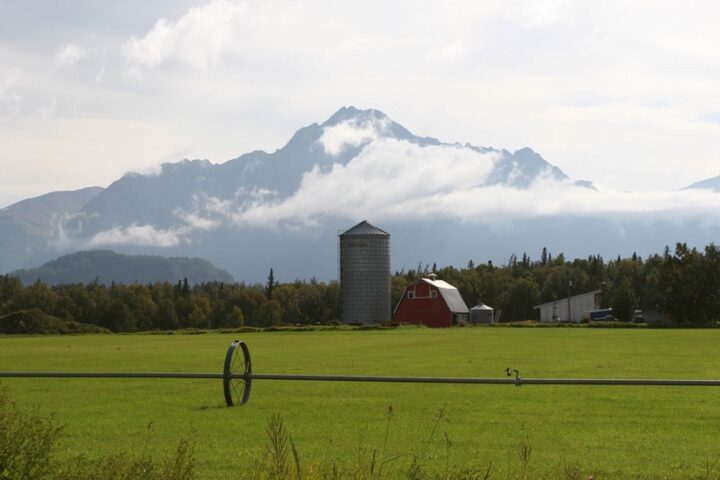This story by Allison Winter appeared on Colorado Newsline on February 17, 2025. We are sharing it in two parts.
Farmers across the United States are finding themselves in precarious economic positions, as they attempt to navigate a strained farm economy and a barrage of executive orders from the Trump administration that put some farm programs in limbo.
In his first month in office, President Donald Trump has issued a flurry of executive orders to pause or cancel federal funding on a range of programs and grants — some of which go directly to farmers.
Even though the administration said it would not stop payments to individuals, and courts have ordered the administration to resume the programs, many farmers are awaiting payments on their contracts and have not been told when or if they can expect to receive expected funding.
Billions of dollars are at stake.
Missouri cattle producer Skylar Holden signed a $240,000 cost-sharing contract with the U.S. Department of Agriculture to improve water systems on his 260-acre cattle operation. After getting approval in January for the next phase of the project and investing upwards of $50,000 in pipes, equipment and labor, Holden says he got a call a week later from his field agent telling him the payments from USDA were on hold.
“I instantly asked … what does that mean for all this money that I just spent, that I’m relying on these funds to come through?” Holden recounted in a TikTok live on Feb. 13.
He said he was told the money was frozen and that it was not clear when or if the payments would happen.
“Then to be honest with you, I just kind of zoned out. I just started running numbers in my head… I was trying to figure out how I could make this work,” Holden said.
He already works another job to try to make ends meet on the farm and cares for his cattle after work. He says the debt on this project could mean disaster for his farm. When asked on a scale of 1 to 10 what his confidence was that the payment would come through eventually, Holden, who voted for Trump, rated the possibility a “one.”
“I guess I have maybe a little bit of hope I will see the funding, but I am not too confident,” Holden said in the TikTok live.
‘Farmers are left wondering’
Representatives from farm advocacy groups and cooperatives say they are hearing similar stories from their members, but most are unwilling to speak publicly for fear of retribution. Many large farm organizations backed Trump’s successful presidential campaign.
“We continue to hear from family farmers and ranchers about the federal funding freeze, which has created significant uncertainty,” said Rob Larew, president of the National Farmers Union, an advocacy group that represents 220,000 farmers and ranchers in 33 states. “The interruption in funding raises concerns about whether USDA will disburse already obligated funds to farmers who have existing agreements with the department.”
“The lack of clarity is leaving state and local agencies and partner organizations struggling to interpret and implement federal programs, while farmers are left wondering if they can rely on these programs as they make critical business decisions for the year ahead,” Larew said.
The financial implications are huge in the administration’s efforts to freeze or cancel funding. One of Trump’s first executive orders called for a pause on all funding from the Inflation Reduction Act, enacted by Democrats during the Biden administration, which provided nearly $20 billion for farmland conservation programs.
Another directive briefly paused all federal financial assistance. Other executive orders put a freeze on all foreign aid and dismantled the U.S. Agency for International Development, significant for American farmers because it purchases grains and goods for food programs and funds some agricultural research projects.
In limbo in Colorado
Roy Pfaltzgraff is trying to navigate the uncertainty on his 2,000-acre gluten-free grain farm in northeast Colorado.
He is struggling to get the farm refinanced, and a recent lender told him they would not calculate government payments — long considered a reliable backup for farmers — as part of his income, even if he has ongoing contracts. His federal contracts have not been canceled, as far as he knows, but he is afraid to spend money on them or pursue new projects.
“My concern is that if we get started and spend a bunch of money with the expectation that we will get some of it paid back, what if we don’t? There are limits on what we can do,” Pfaltzgraff said in an interview.

Pfaltzgraff is also concerned how the pause on USAID programs could affect his farm and others, potentially causing a domino effect on crop prices.
USAID is one of the biggest purchasers of sorghum and other excess grains. Without their purchases, those grains could flood the market and drive down prices.
More than 450 producers around the country have contracts with USAID, according to an analysis by the Institute for Development Impact, and the agency’s purchases at grain elevators benefit many more.
Food for Peace, one of USAID’s programs, provided nearly 4 billion pounds of American-grown food to 58 million people globally in 2022, according to the U.N. World Food Programme.
The abrupt pause for USAID programs also interrupts agricultural research programs at 19 land-grant university-based innovation labs across 17 states — casting an uncertain future for those projects and the foreign grain markets they are attempting to cultivate.
The Soybean Innovation Lab at the University of Illinois announced last week it will close in April. The closure will have an immediate effect on the staff of 30 experts in tropical soybean and longer-term repercussions on their work to develop an emerging market for soybeans in Africa.
The lab’s director, University of Illinois Professor Peter Goldsmith, said he had to make the hard decision to shutter the lab when they were suddenly no longer able to access any of their grant money or reimbursement systems. They are in the middle of work on a $30 million USAID grant that was supposed to last until 2027.
“Where does the money come from to pay salaries, to pay people, to water the plants, I mean everything?” Goldsmith said in an interview. “We’ve run a very tight budget, but I never put into the scenario an act of God like this.”

